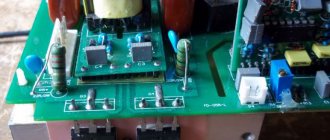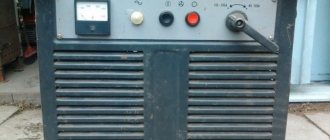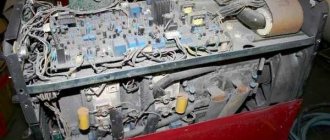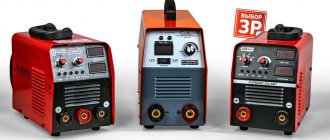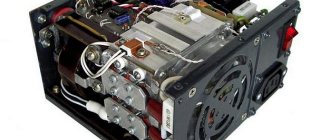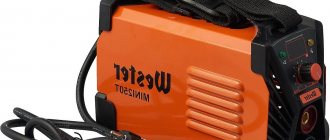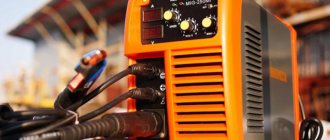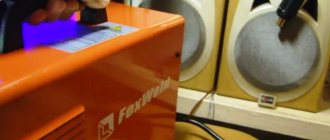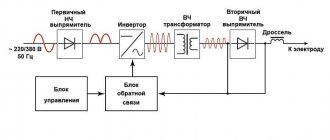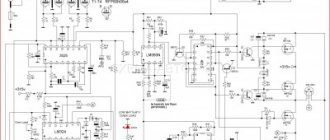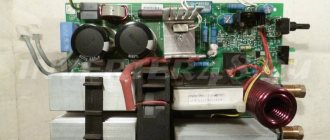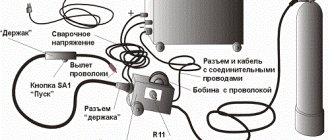In a private home and country house there is always a need to cook something. In order not to contact professionals for small details (and not to pay them), you can buy an inexpensive welding machine and learn it yourself. To acquire these skills, it is recommended to purchase DC welding machines, and in particular, welding inverters. They have small dimensions, weigh little, and with their help you can get a high-quality seam even without much experience. What is equally important, in this category there are good devices at a low price (5-10 thousand rubles). Therefore, welding with an inverter for beginners is the best that the market can offer today.
general information
So why is it necessary to study the instruction manual at all? The instruction manual can be your guide to using the device if you are a beginner. After reading it once you will already receive a lot of useful information and will be able to perform your first welding.
And if you are a welder in production, then studying the instructions is a must. The fact is that the operating instructions for the device allow you to quickly and easily read production instructions for any type of welding work. The production instructions include technical specifications, types of equipment and consumables used, as well as direct operating instructions for the welding machine.
In this article we provide standard instructions for using a welding inverter. Of course, the instructions may differ for each individual welding machine, but the essence of their operation is the same. So after reading this article you will be able to use absolutely any welding inverter without the need to study additional information.
Content:
Any welding work requires the use of specialized equipment.
This includes power sources (transformers, inverters, rectifiers), the welding machine itself, the electrode holder, gas burner, etc. Please note that the set of welding equipment for different welding methods will differ. In addition, the welding equipment itself is different, and its operation can also be different: one is allowed for mobile posts, another can only be used stationary, and so on.
Note that welding equipment and its operation must meet a number of requirements, which we propose to discuss further.
User manual
The operating instructions for the welding inverter consist of several steps that need to be studied once and simply remembered. It will be easier later.
Connecting a network cable
A power cable must be included with the welding machine. Check its integrity. Connect the cable to the inverter and then connect it to a 220V outlet. Check that all connections are correct. Make sure the welder's power light is on.
Connecting welding cables
Any welding inverter has two connectors on its body, marked with the symbols “+” and “-”. Simply put, plus and minus. Cables are inserted into them regardless of the type of work. They just connect. But then the cables need to be correctly connected to the holder and to the part that you will weld. It all depends on what polarity you choose to work with.
If you are going to weld with straight polarity, then connect the negative cable to the holder, and the positive cable to the part being welded. When working with reverse polarity, everything is exactly the opposite. We talked in more detail about the features of working with reverse polarity in this article.
Note that these recommendations apply to DC inverters.
About semi-automatic welding technology
The device for semi-automatic welding works with or without gas, using a special wire.
In a gas environment
Several types of gas are used to hold metal workpieces together, such as carbon dioxide or helium. This is due to its low cost and economical consumption. Gases reduce metal oxidation, making the weld more durable.
When welding with carbon dioxide, preliminary preparation of the material is required - cleaning it from dust, dirt, corrosion and paint. To do this you will need a metal brush or grinder.
There are 3 gas welding techniques used:
- Continuous processing. The electrode or torch is installed at the beginning of the seam and carried to the end.
- Spot processing. With this method, the elements are connected not with a continuous seam, but with a dotted line.
- Short circuit. Used for joining thin metal parts. The material is melted by pulses supplied from a short circuit in the unit. The liquid metal forms the drop needed to create the seam.
To work with carbon dioxide, install the AC function. The unit is adjusted in accordance with the type and thickness of the metal. Gas consumption is determined by the welding mode. The wire melts at the same rate. Having prepared the parts, start the gas supply and activate the welding arc.
To do this, run the electrode over the part and press the “Start” button. The quality of the weld depends on the following nuances:
- Distance from electrode to workpiece. Do not install the wire close to the metal, this makes it difficult to see the seam.
- The gap between the edges of the parts. If the sheet thickness is less than 1 cm, leave a distance of 1 mm. For larger values, the gap is 10%.
- Using a substrate. This tool prevents the melt from flowing out of the seam.
We recommend reading: How to set up a semi-automatic welding machine
Soldering aluminum
Using a semi-automatic machine, various metals are welded, including aluminum. However, there are subtleties associated with the structure of the material. The surface is covered with a thin layer of oxide, which melts at a higher temperature. In this case, argon is used as an auxiliary gas. Aluminum immediately melts, so a substrate is placed under the parts.
The workpieces are connected by fusible electrodes under the influence of direct current. A positive charge is placed on the arc, and a negative charge on the metal. This way the top layer melts faster. Before starting welding, the surface can be cleaned of the oxide film. The parts are installed in any spatial position.
Using wire
Wire welding is performed both with and without gas. The most common method is to use flux. This method is necessary on production sites. The high cost of flux must be taken into account. The material is a powder located in the core of the wire. When melting, a gas is formed that protects the seam from oxidation. There is no additional supply of substance. This semi-automatic welding method for beginners has the following features:
- Can be used in all conditions. When gas welding, the quality of the seam deteriorates in windy weather or in drafts.
- Wire welding is not recommended for thin metal or mild steel. The seam may crack or become deformed.
- To increase the temperature of the welding arc, reverse polarity is used.
Safety precautions
Safety precautions are a mandatory section to study. Do not start work until you remember all the rules.
- Do not use the machine if the cables and/or their insulation, plug, or welding machine body are damaged.
- The welder must use welding gloves and never handle cables with bare hands.
- Be sure to turn off the inverter when not using it.
- Do not switch the welding mode directly during operation, the machine may break.
- If you are not using the device, disconnect the cable leading to the electrode.
- If unexpected situations occur, turn off the inverter using the emergency switch.
- Welding work must be carried out using certified components that meet safety requirements.
- Do not inhale fumes while welding.
- Ensure good ventilation in the workplace.
- Use protective clothing and a mask, do not forget about the hat, shoes and gloves mentioned above. Clothing must be made of non-flammable material.
- Do not allow strangers to your workplace. Or provide them with the proper level of security.
- To reduce the risk of fire, remove all flammable items from the work area.
- Keep a fire extinguisher or any other fire extinguishing equipment nearby. Read the operating instructions for these products.
- Do not work with containers that are under pressure.
- Do not handle uncleaned containers that have contained flammable liquids.
- Do not work in clothing stained with flammable liquids.
- Do not carry matches or a lighter in your work clothes pockets.
- Monitor noise levels while welding. Increased noise levels can lead to partial or complete hearing loss. Use additional hearing protection methods.
Description of equipment
Resistance welding equipment is used in a group of processes in which metals are joined by heat generated by the resistance of the welded object to electrical current, in the circuit of which the object is a part, and by the application of pressure. External device device:
- belt;
- frame;
- display;
- current adjustment;
- power button;
- overheat indicator;
- ventilation grille;
- cable connectors;
- support legs.
What does a welding machine look like?
The internal structure of the machine:
- power block;
- control block.
Rules for welding work
Welding rules may vary depending on the model of welding inverter you use. For example, some models may have increased protection against dust and moisture, and therefore they do not require careful storage conditions and can be used in field conditions.
Also, some inverters are equipped with indicators that indicate overheating of the device. After this, the device must be turned off and allowed to cool. But if your model does not have such an indication, then you will have to monitor the temperature yourself.
If you have temporarily suspended welding work or finished it, turn off the welding inverter from the network. If there are other people in the work area with you, install a special screen for them to protect them from radiation and sparks.
Use protective clothing made of thick, non-flammable fabric, do not forget about a protective mask (we recommend a chameleon mask), shoes and gloves. Shoes should not conduct current. If you don't have such shoes, you can use a rubber mat. Do not store flammable items in your work clothes.
Check the condition of the cables and the inverter itself before welding. Make sure all cables are connected correctly. Follow safety precautions to avoid harm to health.
Before welding, thoroughly clean the surfaces to be welded. There should be no traces of corrosion, oil, dirt, paint, etc. To clean, use solvent, sandpaper, grinding wheels, etc.
General information
More recently, purchasing a welding machine for household needs was difficult. The virtual lack of choice in the welding equipment market limited the capabilities of welders.
You could get a transformer or rectifier, but then you had to study for a long time before you started working. These types of devices are difficult to use and first you need to understand the basics: how to regulate the current strength, how to sew a seam, etc.
A real breakthrough with the advent of the 21st century was the widespread availability of inverters. Their difference from bulky and difficult-to-use transformers immediately attracted mass attention from welders of various categories.
Among the advantages of the inverter are its low weight and small size (on average about 10 kg). This solved transportation problems: welders could easily transport it from one site to another.
The functionality has expanded: a mechanism has appeared to protect against sticking of the electrode to the surface being welded, simple ignition of the arc, etc. It is not surprising that the inverter has become in great demand among consumers.
This type of welding equipment can be found at home, in garages, private workshops, and large enterprises. The inverter got its name because of the welding current source hidden under the inverter housing.
This, in turn, confuses beginners, as it is difficult for them to distinguish between an inverter-type welding machine and an inverter itself. Let us explain that the device used for manual arc welding, usually small in size, is an inverter.
Actually, this is its only purpose. Significantly different from it are inverter-type devices, the scope of which is much wider.
They are used when welding in carbon dioxide or welding with flux-cored wire. As an example, we will give a semi-automatic machine operating on the basis of an inverter current source.
With the advent of the inverter, learning welding has become much easier for the average household welder. The ease of understanding the principles of operation of the device reduces familiarity with it to a banal reading of the instructions.
And you can safely start welding metal structures.
Welding machine maintenance
Basic maintenance of the device is to clean it from dirt and dust. This cleaning must be done regularly. Maintenance of the device must be performed by a specialist at a service center or production site. Do not perform maintenance unless you have sufficient skill and experience.
Before servicing, unplug the device. Wipe all cables and the housing with a damp cloth or a special cleaner if the dirt is ingrained. Do not disassemble the inverter housing unless necessary. Do not use a wet cloth for cleaning. Do not kink wires during cleaning, and generally perform maintenance carefully.
If you give the inverter to a specialist, he should clean the device from dust using compressed air. An air compressor is often used for this. If certain parts are constantly getting oily, they need to be cleaned regularly with a cloth. The specialist should also inspect how securely all the parts are fastened and adjust them, if necessary.
The service technician should also regularly check all cables for breaks or faults. This check must be performed either before sending the device for long-term storage, or once a month.
Arc gap control
Welding arc diagram
You can speak with confidence about the initial skills of a welder when you develop the skill of correctly forming and holding the arc gap - the welding arc.
In fact, this is a simple process, the main thing in it is the understanding that the arc will be constant and melt the electrode most efficiently with the correct, slightly slow movement of the holder.
In many ways, this is achieved by trial and error - a consolidated skill will appear when, when moving the electrode, a homogeneous seam begins to form, connecting both parts being connected.
Storing the welding machine
Storage of the device is no less important than its proper operation. The service life of the inverter and the frequency of its breakdowns largely depend on storage.
The inverter can be stored in the box in which it was supplied. But it is better to use plastic packaging. This can be a bag made of thick polyethylene, roll packaging, etc. In short, protect your device from dust, dirt, water and snow. In this case, there is no need to pack the inverter tightly; leave holes for air access.
Modern devices can be stored at extreme temperatures (from +50 to -20 degrees), but we do not recommend experimenting. It is better to store the inverter at room temperature. Do not store the device directly on the ground (even in its packaging), in a damp basement or in a place with high humidity.
Features of operation
Ease of operation distinguishes inverter welding from transformer welding. To start welding work, you just need to power the inverter from a regular home power outlet.
To smooth the incoming alternating current, a rectifier filter is built into the device. Transistors are responsible for converting direct current into high-frequency alternating current. Now the frequency is 20-50 kHz.
This is just the first stage. The next phase is to reduce the high frequency alternating current. The value of the welding current will be about 100-200 Amperes.
Tips and possible mistakes
When starting to use a welding inverter, the most important thing you need is to be patient; more than one pack of electrodes will go away before you get a really beautiful seam.
But you need to strive for this from the first time you turn on the device, and the following points will help a lot:
- At the initial stage , it is enough to learn how to hold the arc so that the electrode heats up evenly.
- In the first lessons, it is recommended to first learn how to form a horizontal seam, and only then diversify the tasks - welding vertical and ceiling elements.
- It is important to get into the habit of cleaning rust and deposits from the joints.
Rules for forming a weld seam
Obtaining a strong and reliable weld joint is largely the result of proper movement of the electrode in the weld pool. Quite primitively, this can be described roughly as the process of learning to write.
The movement of the hand with the holder is reminiscent of a first-grader's copybook, when the skills are quite weak and you have to draw zigzags, circles, or oblique lines. But at the same time, in addition to movement in one plane, when welding, you need to either bring the electrode closer or, on the contrary, remove it.
Such movements make it possible to form layers of metal in the weld pool, as if overlapping each other, and this ensures a perfectly formed connecting seam.
